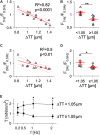The Degree of t-System Remodeling Predicts Negative Force-Frequency Relationship and Prolonged Relaxation Time in Failing Human Myocardium
- PMID: 32231589
- PMCID: PMC7083140
- DOI: 10.3389/fphys.2020.00182
The Degree of t-System Remodeling Predicts Negative Force-Frequency Relationship and Prolonged Relaxation Time in Failing Human Myocardium
Abstract
The normally positive cardiac force-frequency relationship (FFR) becomes flat or negative in chronic heart failure (HF). Here we explored if remodeling of the cardiomyocyte transverse tubular system (t-system) is associated with alterations in FFR and contractile kinetics in failing human myocardium. Left-ventricular myocardial slices from 13 failing human hearts were mounted into a biomimetic culture setup. Maximum twitch force (F), 90% contraction duration (CD90), time to peak force (TTP) and time to relaxation (TTR) were determined at 37°C and 0.2-2 Hz pacing frequency. F1 Hz/F0.5 Hz and F2 Hz/F0.5 Hz served as measures of FFR, intracellular cardiomyocyte t-tubule distance (ΔTT) as measure of t-system remodeling. Protein levels of SERCA2, NCX1, and PLB were quantified by immunoblotting. F1 Hz/F0.5 Hz (R 2 = 0.82) and F2 Hz/F0.5 Hz (R 2 = 0.5) correlated negatively with ΔTT, i.e., samples with severe t-system loss exhibited a negative FFR and reduced myocardial wall tension at high pacing rates. PLB levels also predicted F1 Hz/F0.5 Hz, but to a lesser degree (R 2 = 0.49), whereas NCX1 was not correlated (R 2 = 0.02). CD90 correlated positively with ΔTT (R 2 = 0.39) and negatively with SERCA2/PLB (R 2 = 0.42), indicating that both the t-system and SERCA activity are important for contraction kinetics. Surprisingly, ΔTT was not associated with TTP (R 2 = 0) but rather with TTR (R 2 = 0.5). This became even more pronounced when interaction with NCX1 expression was added to the model (R 2 = 0.79), suggesting that t-system loss impairs myocardial relaxation especially when NCX1 expression is low. The degree of t-system remodeling predicts FFR inversion and contraction slowing in failing human myocardium. Moreover, together with NCX, the t-system may be important for myocardial relaxation.
Keywords: cardiac excitation-contraction coupling; cardiac remodeling; force frequency relationship; heart failure; human heart; transverse tubular system.
Copyright © 2020 Abu-Khousa, Fiegle, Sommer, Minabari, Milting, Heim, Weyand, Tomasi, Dendorfer, Volk and Seidel.
Figures




References
-
- Crossman D. J., Young A. A., Ruygrok P. N., Nason G. P., Baddelely D., Soeller C., et al. (2015). T-tubule disease: relationship between t-tubule organization and regional contractile performance in human dilated cardiomyopathy. J. Mol. Cell Cardiol. 84 170–178. 10.1016/j.yjmcc.2015.04.022 - DOI - PMC - PubMed
LinkOut - more resources
Full Text Sources
Research Materials
Miscellaneous

